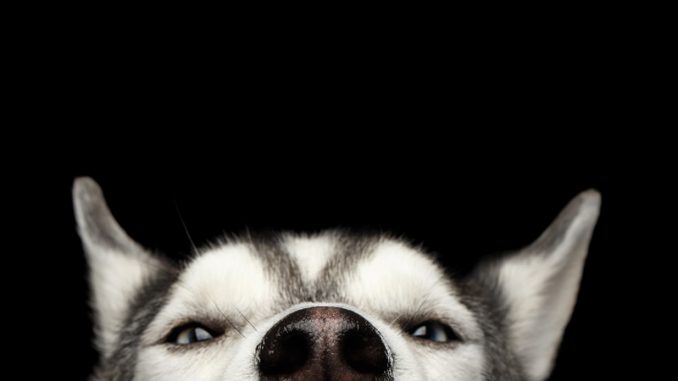
Thanks to their versatility, intelligence, loyalty, and affection, Siberian huskies are among the most popular dog breeds today. So popular that when most people think of a husky, they’re referring to the Siberian husky.
Siberian huskies have an unmistakable appearance with wolf-like characteristics. They stand between 20 to 24 inches tall and weigh up to 60 lbs.
Siberian huskies are loyal and loving, but they can be willful, independent dogs too. They require early socialization and training. Due to their strong work ethic, they make excellent companions and pets – even around small children.
Siberian huskies need a lot of exercise and attention, otherwise, they become bored, which leads to destructive habits around the house like chewing shoes and destroying furniture.
If you’re the type of person who works long hours and can’t dedicate a lot of time to your dog, the Siberian husky is not the right breed for you.
TABLE OF CONTENTS
Siberian Husky Quick Summary
| Breed Type | Spitz |
| Suitable For | Highly Active households |
| Size | 21 to 24” (male) and 20 to 22” (female) |
| Weight | 45 to 60 lbs (male) and 35 to 50 lbs (female) |
| Lifespan | 12 to 15 years |
| Color Variations | Black/White, Gray/White, Red/White, Sable, Agouti, White, Wooly |
| Temperament | Intelligent, energetic, loyal, outgoing |
| Daily Exercise | High – At least 80 minutes per day |
| Daily Food Consumption | 2 cups of dry food per day |
| Known Health Issues | Hip Dysplasia, Cataracts, Corneal Dystrophy, Hypothyroidism |
| Cost | $800 – $1500 on average |
| Shedding Level | High |
Siberian Husky Appearance
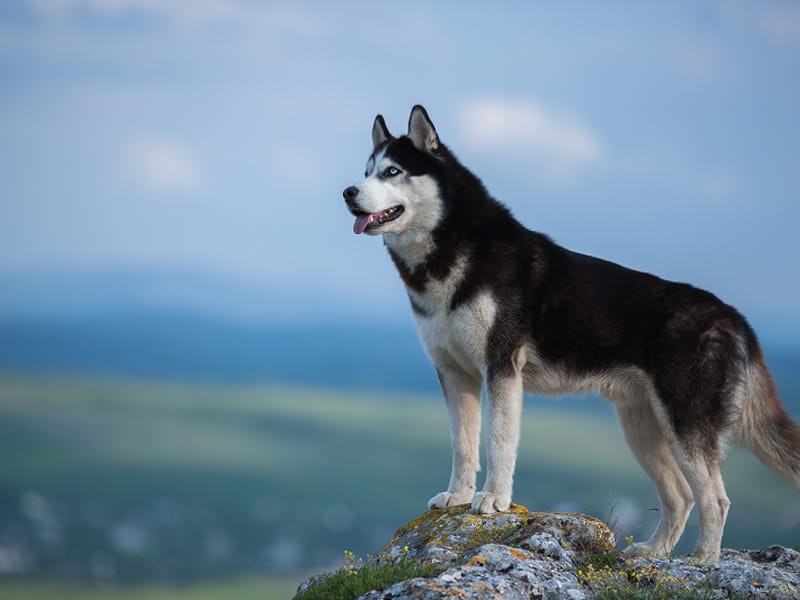
The Siberian husky has a distinctive appearance known widely for its striking eye color variations. It’s a medium-sized, sturdy, well-formed dog. Its head is broad, practically square, and covered with short, thick fur.
Many Siberian huskies have defined markings called facial masks that cover their muzzle and span between their eyes. Not all of them will be born masked, but you’ll notice it most distinctly as puppies. As the puppies start to grow up, their facial mask will change too. Some will fade into a solid color while others will turn gray.
Once the Siberian husky ages out of the puppy stage, its ears stand tall and erect, similar to a wolf. Its strong legs and wide chest make them perfect for working and sled pulling. A Siberian husky has a double coat, consisting of an insulating undercoat and topcoat, which is water-resistant and soft to the touch.
Their eyes, not only striking in color, are a distinct almond-shaped that helps protect them from the glaring snow in winter.
How Big Do Siberian Huskies Get?
Siberian huskies are medium-size dogs, standing between 20 and 24 inches at the shoulder and weighing between 45 and 60 pounds as an adult.
As puppies, Siberian huskies tend to grow up quickly. Starting between 2 to 6 lbs, you will notice the most growth between ages 3 to 9 months old. Siberian huskies will more than double in size during this period from 20 to 50 lbs. As they come upon their one-year mark, most Siberian huskies will be between 40 to 60 lbs. They are considered to be full-grown at this age, but their size can vary depending on gender.
Male Siberian huskies tend to be larger than their female counterparts. Like wolves, huskies are pack animals with males as the leaders. Males are responsible for protecting the pack, which is why they are bigger and more powerful. They stand a few inches taller, between 21 to 24 inches, and weigh up to 20lbs more than females.
Female Siberian huskies are smaller than males, but not always by a significant amount. They stand between 20 to 22 inches tall and can weigh up to 50lbs.
Coat
Siberian huskies, including the striking Red husky and White husky variants, possess a distinctive double coat, which means their coats consist of two layers – the undercoat and the topcoat.
The dense undercoat consists of short, thick hairs. These hairs act as a layer of insulation on cold days and can protect huskies from heat as well. If you notice a Siberian husky looking extra fluffy, that means they have a thicker undercoat.
The topcoat consists of longer hairs known as guard hairs. The length of guard hairs can vary but are usually no more than a few centimeters long. The longer topcoat is water-resistant and can aid in repelling dirt from sticking to its fur.
In winter, the Siberian husky’s topcoat acts as insulation, helping keep the body warm, while the inner, dense, water-resistant coat repels snow and sleet. In summer, the double coat acts in reverse. The dense undercoat protects dogs from sunburn while the guard hairs allow air to circulate freely, keeping the dog cool.
As with many dog breeds, Siberian huskies have a range of coat color variations.
Here are the nine standard Siberian husky coat colors:
- White
- Black
- Black and White
- Black Tan and White
- Agouti and White
- Brown and White
- Gray and White
- Red and White
- Sable and White
Eye Color
One of the most distinctive features of a Siberian husky is its eye color variation. The most common eye colors are arctic blue or different shades of brown, but they’re also known to be bi-eyed or particolored.
Bi-eyed Siberian huskies have one blue eye and one brown eye, while particolored huskies have a mix of blue and brown in each eye.
The color variation stems from a hereditary disease known as Heterochromia, which causes a lack of melanin pigmentation in the eye’s iris. Siberian huskies are prone to eye disease, but heterochromia is physically harmless.
Siberian Husky Origins
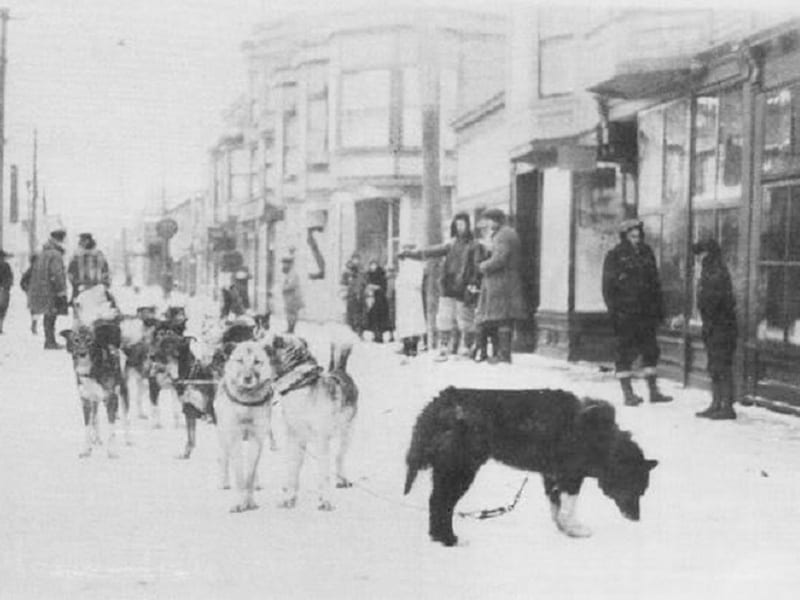
The Siberian husky (Canis lupus familiaris) is a dog breed of the Spitz type, bred first in the northeastern most regions of Asia by the Chukchi people in the early 20th century. The Chukchi used huskies as companions and working dogs, primarily for sled pulling and guarding their homes.
In the early 1900s, the Chukchi people encountered a man named William Goosak.
He was a fur trader who used sled dogs to traverse Siberia and transport his goods. In 1908, Goosak traveled to Alaska with his Siberian husky for the All Alaska Sweepstakes dog race. His dog was the first known Siberian husky brought into America.
Since then, countless competitive dog racers have used Siberian huskies as part of their sled teams, contributing to the rising popularity of the breed throughout modern history.
Siberian Husky Personality and Temperament
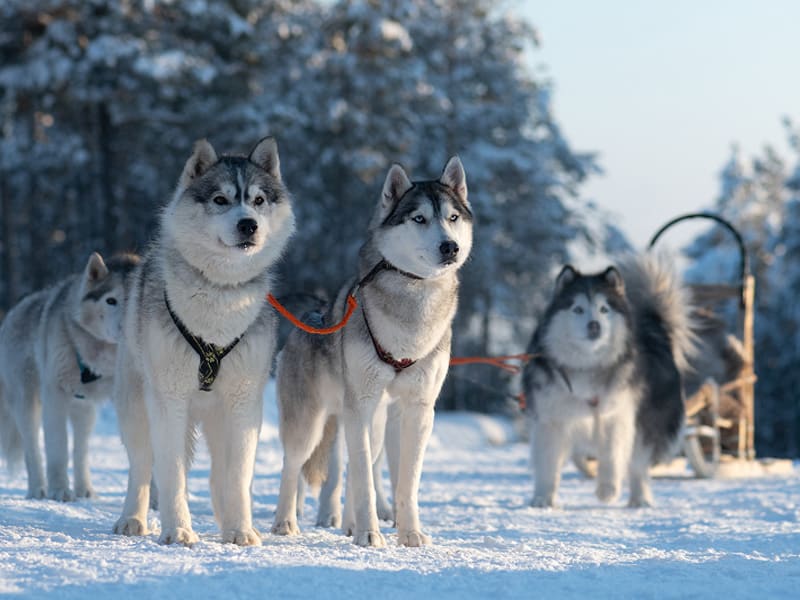
Siberian huskies are a loyal and hard-working breed, making them capable of performing a wide range of activities from sled pulling and herding to guarding property. With a dominant pack leader at the helm, they will quickly form bonds with their human families.
In general, Siberian huskies are social dogs. They get along with children and other dogs but keep them away from cats and small furry animals. They have a high prey drive, meaning a strong instinct to hunt, stalk, chase, and capture prey. Training techniques like recall, proper leash walking, and reinforcing good behavior can help mitigate their intense prey drive.
Siberian huskies can have stubborn and unruly traits as well. Females tend to be more independent as males rely more on their pack. As one of the most vocal breeds, they use a combination of howling, barking, and whining to communicate. Depending on your personality type, you might not enjoy this aspect of being a husky owner.
Taking Care of a Siberian Husky

When it comes to fulfilling their physical and training requirements, caring for a Siberian husky is a lot of responsibility. Be prepared to invest extra time, devotion, and patience in those areas.
Neglecting those areas will lead to your dog becoming bored and destructive, so best to build a husky-proof home. Remove anything they can easily chew, destroy, or eat.
Otherwise, huskies are a fun breed that won’t require extensive care beyond occasional coat brushing, tooth brushing, and nail clipping.
Food Needs
Siberian huskies will eat between 250 to 300lbs of food per year depending on their size and activity level. At a minimum, Siberian huskies should eat at least 1lb of dry dog food per day, meaning one cup in the morning and another at night. More active dogs will require more food.
Considering how much energy Siberian huskies burn daily, they need a high-quality, nutrient-rich diet to refuel. As a puppy, they need a higher amount of nutrients than adults, so look for natural dog foods with real meat listed as the first ingredient. Most brands will offer different recipes for puppies versus adult dogs.
Keep in mind that switching between different dog foods can upset a husky’s stomach, so any changes in their diet should be gradual.
Grooming Needs
Siberian huskies have a double-coat that sheds twice per year, once in the summer and again in the winter. Known as “blowing the coat,” the undercoat will shed completely to allow for huskies to accommodate seasonal temperature changes.
Regular brushing is required once a week to help keep their coat healthy and free of tangles. Trainers encourage owners to allow their Siberian huskies to practice self-cleansing, so a bath is only necessary every six weeks.
Exercise Needs
Siberian huskies are active dogs who require at least 80 minutes of rigorous daily activity. Remember, they were bred to run, so it’s important to let them burn off that energy to keep their activity levels and your sanity in check.
Plan for at least an hour of running along with a few 20-minute walks every day. As long as they’re under supervision, Siberian huskies benefit from having a fenced-in yard to run around in. Don’t leave them alone in the yard, as they have a tendency to try and escape.
You don’t need to have a fenced-in yard or a big living space to own a Siberian husky, so long as you can fulfill their running requirements. You can bring them with you on your daily run or take them to a local dog park to play and tire them out.
Mental Needs
When Siberian huskies get bored they will display destructive habits, so it’s important to keep them entertained mentally. Activities like daily walks, socialization with other dogs, and obedience training will help stimulate their mind.
While at home with your husky, bonding is essential for their mental health. Talking to them helps get them used to your voice along with understanding new phrases. At least 30 minutes of interactive playtime like tug-of-war or fetch is essential.
Once you start leaving your husky at home alone, interactive puzzle toys will help keep their attention and cure their boredom.
Common Health Concerns
In good health, a Siberian husky can live up to 15 years. However, as with all dog breeds, they’re prone to certain health issues.
A few common health concerns for Siberian huskies include:
- Hip dysplasia, an inherited condition that affects the hip joints, causing pain and lameness. It can affect dogs as young as four months of age.
- Cataracts. Another eye condition, this one is caused by excessive buildup on the lens of the eye. It can lead to blindness in older dogs.
- Glaucoma. This condition occurs when the pressure inside the eye rises, damaging the optic nerve and leading to blindness.
Siberian huskies can also suffer from separation anxiety, a behavioral health issue that stems from dogs that are over-attached to their owner. This can lead to excessive howling and destructive behavior.
Training a Siberian Husky dog
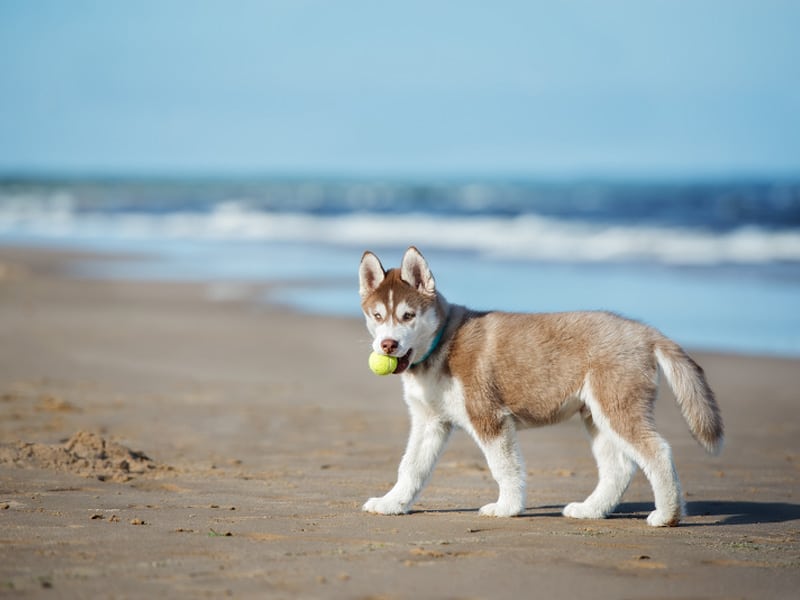
Siberian huskies are an intelligent breed, which can be a great asset for training, but it can also be a detriment. They’re independent dogs and can be stubborn, making them difficult to train – especially for first-time dog owners.
It takes patience and persistence to teach a Siberian husky a new trick, so it’s best to start puppy training Siberian huskies as as possible. Pack dogs need to have a leader, so you need to establish a hierarchy with you as the alpha as early as possible. When your husky recognizes you as the alpha, basic training will become easier.
Here are some puppy training tips to help have a well trained Siberian husky:
- Establish yourself as the alpha.
- Start with the basic cues like sit, stay, down, and come in a controlled environment. Focus each training session on one command only.
- Use respect training techniques like positive reinforcement to reward good behavior with treats and praise. Never use violence to discipline bad behavior. Instead, use an assertive tone or ignore your husky for a few minutes and try again.
- Start training in new environments and situations. Known as “proofing,” this technique will train your dog to listen to commands in all environments, even chaotic ones.
- Give your husky at least 80 minutes of active exercise daily. Letting them burn energy physically will help them focus mentally when it’s time for training.
Siberian Husky Price

In general, Siberian huskies are expensive. Prices can vary depending on their age or whether you purchase from a breeder versus adopting from a shelter.
How Much is a Siberian Husky?
A Siberian husky costs between $800 and $1500. The cost will be more expensive if bred from a prized lineage. Keep in mind that this price range will vary depending on the breeder as well.
Be sure to research a husky breeder before bringing one home. A reputable breeder will provide thorough health evaluations, a health guarantee, and a home visit to ensure that you and their husky will be a good match.
You can also contact your local humane society to see if any Siberian husky puppies are available. Many shelters have rescue programs where they take in unwanted dogs from owners. This route can be a more affordable option, with prices ranging from $50 to $450.
Due to their popularity, you’ll have a more difficult time finding a Siberian husky in local shelters versus inquiring with a breeder directly.
How Much Does it Cost to Raise a Siberian Husky?
In addition to the upfront cost of a Siberian husky, you’ll also be responsible for the cost of food, toys, veterinary care, and grooming.
If you raise a husky as a puppy, the first year will be the most expensive, partly due to the cost of initial supplies like a dog crate, collar, leash, and toys, but also due to veterinary costs. Depending on if you get them neutered or spayed, vet costs for the first year can be up to $1,000.
There are available battery-operated collars in the market that use Dog Collar Battery Packs that you can check.
After the first year, the average annual cost of raising a Siberian husky is about $600.
Siberian Husky FAQs
- Do huskies get jealous?
- Are huskies high maintenance?
- Do huskies need a lot of space?
- Is it better to have one husky or two?
- Do huskies need a lot of attention?
- Are huskies good for first time dog owners?
- Are huskies smart?
- Do huskies shed a lot?
- Do huskies bark a lot?
- Are huskies good guard dogs?
- Are huskies hard to train?
- Should I get a male or female husky?
- Is a husky a wolf?
- Are huskies friendly?
- How do I punish a husky?
- Is a husky a bad dog?
- Are huskies good family dogs?
Should You Get a Siberian Husky

Whether you want one as a guard dog, working dog, or family pet, Siberian huskies can be a great addition to your household.
If your circumstances don’t allow for frequent walks, outings, and playtime, your husky is likely to become bored and destructive. They require an authoritative, experienced pack leader, making them an ill-suited choice for first-time dog owners.
Siberian Huskies are Suitable for:
- People with an active lifestyle. Huskies need people who can set aside at least an hour a day for running, plus a few daily walks, training, and bonding sessions.
- Active people with children. With proper training and established boundaries, huskies are loyal family dogs and great with children.
Siberian Huskies are NOT Suitable for:
- First-time dog owners. Siberian huskies are tough to train and require a strong, experienced pack leader.
- Inactive people and households. Lack of rigorous daily exercise causes huskies to become stubborn and destructive.
- People who are away from home for long periods. Huskies are quick to bore and need to feel like they are part of the pack. They can also experience separation anxiety.
- People with cats and other small pets. Since Huskies have a high prey drive, they will try to hunt smaller pets in the house.

Be the first to comment